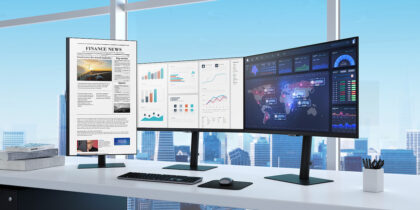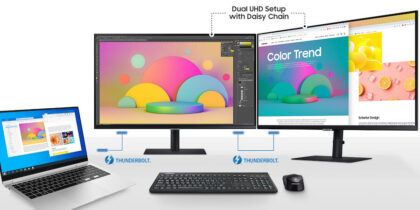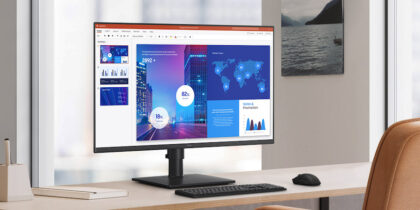Even if you’ve only taken a casual interest in a new monitor, it’s often impossible to tell the difference between the technologies vying for your attention, especially as they continue to evolve.
Take in-plane switching (IPS), for example. Why might you want a monitor with an IPS panel as opposed to another type of panel? To answer that, of course, you have to understand what an IPS panel monitor is — and how it differs from other monitor panel types.
What are IPS panels?
Almost all monitor panels are variations of LCD technology, and in monitors with an IPS panel, a layer of liquid crystals is sandwiched between two glass surfaces. The liquid crystals are arranged parallel to the surfaces — in other words, in the same plane. When the crystals receive an electrical signal, they reorient to produce an image.
Which monitor is best for your workstation?
Get personalized recommendations on the optimal monitor setup for your space. Download Now
IPS panel technology first became mainstream in 1996 and has been refined ever since. Its main objectives were to offer greater off-axis coherence — so that when the screen is viewed from an angle, the colors maintain their realism — and to provide superior color fidelity.
Different types of panel monitors
In addition to IPS, there are a couple of other types of monitor panels — also based on LCD technology, each with specific advantages:
TN panel monitors
Twisted nematic (TN) technology is what first made LCD panels both practical and affordable. TN panels block their backlighting when they’re electrically charged, but when they’re not charged they “twist” to allow light to shine through. These panels require such low voltages to operate that they can conceivably run on battery power.
TN panel monitors are the oldest and most affordable LCD-based panel monitors — which naturally makes them a popular choice. As well as being budget-friendly, TN panel monitors may also have very fast response times and refresh rates, depending on the software being used.
On the downside, TN panel monitors have relatively poor color reproduction and quite restricted viewing angles. Viewed from radically off-axis, the TN panel monitor shifts its colors to the point of inverting them.
VA panel monitors
Vertical alignment (VA) panel monitors were developed specifically to address the shortcomings of TN panel monitors. As the name suggests, they feature vertically aligned liquid crystals that “tilt” when electrically charged, letting light shine through. VA panel technology is common among curved monitors.
VA panel monitors have far more realistic color reproduction than the TN equivalent, and offer more comfortable viewing from an angle. They’re also adept at creating deep blacks, and so offer better contrast ratios.
IPS vs. VA
These two technologies each have their own strengths. IPS is recognized for its color accuracy and consistency, as well as its maintained performance when viewed from an angle. Alternatively, VA panel monitors can offer superior contrast ratios and fractionally faster response times.
The benefits of IPS panel monitors
Regardless of the specific type of panel monitor, LCD panel monitor performance comes down to four main aspects:
- Color reproduction: IPS panel monitors excel here, and anyone who requires the best color accuracy and consistency really has no better option than an IPS model. Support for professional color space technologies (such as Adobe RGB) also makes them a compelling option for any work that relies on color fidelity, such as the creative industry.
- Viewing angle: A viewing angle of 178 degrees, both horizontal and vertical, serves even the most demanding use cases. Anyone who needs reliable color reproduction from any angle, such as video editors, photographers and graphic designers, will reap the benefits of an IPS monitor.
- Response time: In the early days of IPS, input lag was a shortcoming, which was more than enough to put off serious gamers and other users who value response time. But IPS monitors’ response times have improved, to the point that only the most intense gamers (or people who value razor-sharp response times over visual experience) will argue against IPS.
- Contrast ratio: VA panel monitors are a little more accomplished at delivering deep black, and therefore are a better choice if strong contrast is a priority. IPS panels are not far behind, though.
IPS monitor panels typically serve as compact flatscreens — like Samsung’s 24-inch S40UA — while VA panels are widely adopted for curved monitors, like Samsung’s 49-inch S95UA. Both panel technologies provide numerous benefits across all use cases and industries.
From ultra-wide monitors to comfortably consolidated screens, Samsung has the perfect monitor for your needs and budget. And you can learn more about how monitor color technology and refresh rates support your fast-paced, creative workplace in this free guide.








